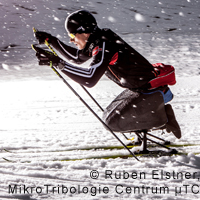Optimised custom-made skis
Winning a ski race is a question of seconds, which is why getting the best equipment possible is so important. This applies to able bodied athletes and paraplegics alike. The development of sports equipment especially adapted to the requirements of physically challenged competitive athletes however is still in its infancy. This is partly due to the relative lack of interest on the part of sponsors, and partly because many winter Paralympic disciplines are still fairy new. The Paralympic Games began just over fifty years ago, and one of the earliest advocates of Games for people with disabilities was a doctor named Ludwig Guttmann. Dr Guttmann believed in using sports therapy to enhance the quality of life for people who were injured or wounded during World War II. Building on Dr Guttmann's legacy, a team of German researchers from the Fraunhofer Institute for Mechanics of Materials IWMhas been working on improving ski equipment for people with disabilities. For the first time, competitors will have the chance of lining up with optimised skis adapted to their individual needs. Researchers have been working with industry partners to create optimised ski sledges for handicapped cross-country and biathlon skiers. "Our aim is to construct optimised ski sledges for all competitors based on bio-mechanical relationships," says Prof. Matthias Scherge, head of the tribology business area at IWM and coordinator of the project consortium. The challenge in relation to this is that the degree and nature of the physical disability is different for each athlete, and that athletes are required to perform in a very specific seated position. "For this reason, every athlete essentially requires a unique solution," he explains. The athlete's customised seat shape is first determined in a simulation model. For this, the athlete sits in a cross-country ski sledge, and supports himself with ski poles. Partners from the Institute of Sport and Sport Science at the University of Freiburg, Germany attach markers to various parts of the athlete's body to map the sequence of movements. Sensors in the poles measure the transmission of energy while the athlete pushes off. The results are fed directly into a simulation programme, which then creates a bio-mechanical model. This model allows the rough geometry of the seat to be derived. For the detailed design, the athlete is scanned in three dimensions, and an additional simulation enables the experts to analyse areas where excess weight can be saved without affecting the stability of the material. This optimised lightweight prototype is then manufactured directly from the design data, which means that the cost of the sports equipment is kept within reasonable limits. Normal racing skis can be attached to the sledge. "However, the skis move differently under the sledge than they would do during normal skiing. They are only being moved in a straight line," says Scherge. "This must be taken into consideration during the grinding process." For this reason, the IWM researchers have developed special ski grindings for use under ski sledges, in collaboration with a ski manufacturer. Fine tuning is required, in order to specially adapt the skis to the individual athlete. For example, the weight of the athlete affects the surface in contact with the snow. Coatings developed by IWM ensure that the skis are able to glide through the snow with minimal friction. The project planners intend carry on optimising their developments until 2014m and the consortium is open to additional cooperation with interested parties. Prof. Scherge also hopes that the Paralympics will help to encourage those with disabilities to participate in recreational sports. "It would be nice if the Paralympics could provide disabled people with new sport-related perspectives when it becomes clear that everything is possible with the right technical support," he says.For more information, please visit: Fraunhofer Institute for Mechanics of Materials IWM http://www.en.iwm.fraunhofer.de/nc/news/
Countries
Germany



